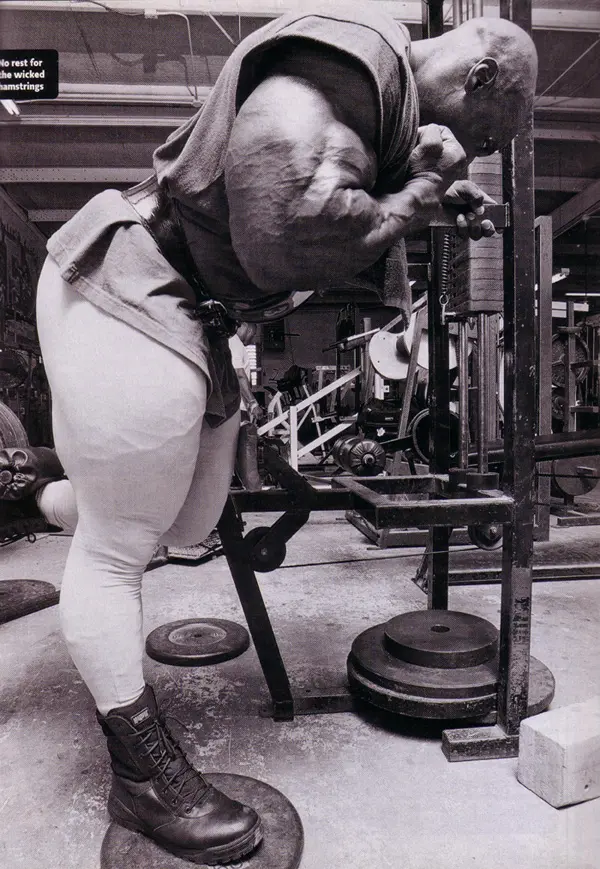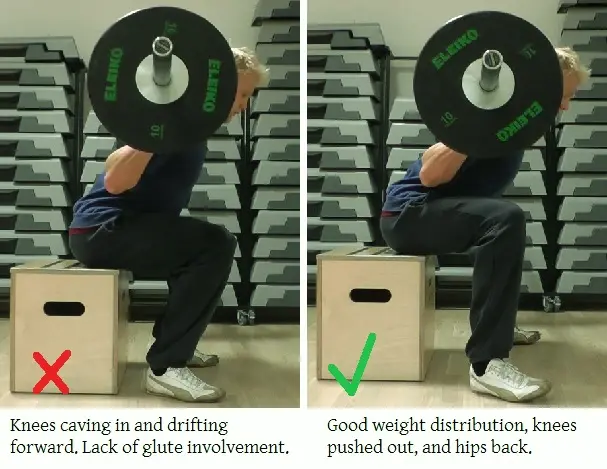Squats are one of the best lower body exercises you can do. Whether you want to build muscle, get super-strong, improve athletic performance, or sculpt a rock-hard booty, squats will help. Because of this, squats are often called the king of exercises.
But, as good as squats are, you can’t do the same old exercises over and over again and expect to keep making progress. Your body will eventually adapt and get used to the exercises in your workouts, and when that happens, your progress will stall. This is true of any exercise, even the mighty squat.
Avoid this problem by spicing up your workouts with new exercises every couple of months. For squats, this means switching from barbell back squats to things like front squats, safety bar squats, goblet squats, or overhead squats. Studies tell us that exercise variety is every bit as important as the weights you lift and the rep and set scheme you use for getting stronger and more muscular (1).
Another squat variation you can use to shake up your leg workouts is box squats. Box squats are very popular in powerlifting circles, but bodybuilders, athletes, CrossFitters, fitness models, and general exercisers can all use and benefit from this exercise too. While box squats and regular squats are very similar, there are also some important differences that mean one may be better than the other for your training goals.
Regular squats vs. box squats
Regular barbell squats are a popular and effective exercise. Best done in a squat or power rack, barbell squats are the most common type of squats. If someone mentions squats, this is they variation they are probably talking about.
With regular squats, you rest and hold a barbell across your shoulders and descend until your thighs are roughly parallel to the floor, although actual squat depth depends on several factors including your flexibility, knee and hip health, and height and leg length. With regular squats, you have to judge how far you need to go down, either by feel or by watching yourself in a mirror. A coach could also give you feedback.
Level Up Your Fitness: Join our 💪 strong community in Fitness Volt Newsletter. Get daily inspiration, expert-backed workouts, nutrition tips, the latest in strength sports, and the support you need to reach your goals. Subscribe for free!
If you’ve been doing nothing but regular squats for a while, it may be time to expand your exercise repotoire with box squats. As you will learn in this article, box squats offer some advantages over regular squats. This doesn’t mean box squats are better. It’s just that they are different enough to help keep your workouts fresh and interesting.

What are box squats?
As the name implies, box squats involve squatting down until your butt touches a box or bench placed slightly behind you. The height of the box depends on your natural squat depth but, generally, should be set so that your thighs are parallel with the floor at the bottom of each rep.
Box squats work the same muscles as regular squats. The main muscles are:
- Quadriceps– quads for short, these muscles are located on the front of your thigh. Their primary function is extension of the knee.
- Hamstrings– located on the rear of your thigh, these muscles are responsible for knee flexion and hip extension.
- Gluteus maximus– glutes for short, and also known as your butt, this is the largest muscle in the human body. Its principal function is hip extension.
- Adductors – located on the inside of your thighs, these muscles are responsible for drawing your leg in toward the midline of your body. There are three adductors: Longus, brevis, and magnus.
- Abductors – the muscles of the outer hip responsible for lifting your leg out and away from the midline of your body. The main abductor muscles are gluteus minimus and medius, and tensor fascia latae, or TFL for short.
- Erector Spinae– the collective name for the muscles that run up either side of your spine. They are responsible for extension of your spine and also keeping your spine stable and rigid during squats.
- Core– the collective term for the muscles of your midsection, including rectus abdominus, obliques, and transverse abdominus.
How to do box squats
To get the most from box squats, you must do them correctly. While you can injure yourself doing any strength training, the risk is particularly high with box squats, especially if you are lifting heavyweights.
Follow these steps to make sure every rep of box squats you do is as safe and effective as possible.
1– With your barbell in a squat rack set to about shoulder-height, place an appropriately sized box or bench behind you.
2– Grip the bar with a slightly wider than shoulder-width grip, duck under it, and position it across your upper back. Pull your shoulders down and back, lift your chest, and brace your abs.
3– Unrack the bar and step back toward the box. Position your feet so they are at least shoulder-width apart, toes turned slightly outward.
4– Inhale, reset your abs, push your hips back, and bend your knees. Descend slowly and smoothly until you are sat on the box. Do not slam down onto the box; land lightly.
5– Sit on the box for 1-2 seconds, but do not relax. Stay tight!
6– Drive off the box and stand up while keeping your core tight and your spine neutral.
Level Up Your Fitness: Join our 💪 strong community in Fitness Volt Newsletter. Get daily inspiration, expert-backed workouts, nutrition tips, the latest in strength sports, and the support you need to reach your goals. Subscribe for free!
Box squats are usually done with the barbell resting on your upper back – a back squat. However, there is nothing to stop you from doing box front squats, box goblet squats, box safety bar squats, or even box Zercher squats. Adding a box to your squat workout will provide you with extra strength and muscle-building variety.

The advantages and benefits of box squats
While all forms of squats are beneficial, box squats offer a few additional advantages and benefits:
1– Box squats keep you honest– it’s human nature to look for easy ways out when your training starts to get hard. In squats, that often means not descending as deep as you should. Shallow squats are not as effective as full-range squats, so you must hit the right depth on each and every rep. Box squats help keep you honest; you know that, if you don’t touch your butt on the bench, you are cheating. Box squats give you a depth target and remove any doubt over whether you are squatting deep enough or not.
2– They teach you to squat properly– a good squat starts with pushing your hips back. However, a lot of people initiate each squat rep by bending their knees first. This not only reduces the amount of weight you can lift but also increases wear and tear on your knees. Having a box behind you reminds you to push your hips back as you start to descend. This is the correct way to squat.
3– More posterior chain activation– box squats are typically done with a wider-than shoulder-width stance. This increases inner thigh and posterior chain activation. Your posterior chain is basically your glutes and hamstrings. Squats are usually thought of as a quadriceps-dominant exercise but, with box squats, your hamstrings and glutes receive more muscle and strength-building attention.
4– More power “out of the hole”– in powerlifting, the hole is the bottom position of the squat. Because of leverage, it’s the point at which the weight feels heaviest and where you are most likely to get stuck. Box squats involve a brief pause at this point, and that means you have to work extra hard to get the weight moving again. This will increase your power out of the hole, and that will make this common sticking point, less of a problem when you return to regular squats.
5– Less knee stress– the wider stance and hips-first descent mean your shins will remain more vertical than they do during regular squats. This takes a lot of strain off your knees. If you have knee pain that is usually made worse by regular squats, try box squats to see if they feel easier on your knees.
6– More core tightness– your core should be tight whatever type of squat you do, but it’s especially important with box squats. As you descend and then pause with your butt on the box, you have to work extra hard to keep your midsection tight and rigid. You cannot relax and, if you do, you probably won’t be able to stand back up. Learning to stay tight during every rep will boost your regular squat performance, and also strengthen your core muscles.
7– Better rep speed– when you do regular squats, especially as you start to get tired, you may be tempted to drop fast and bounce up out of the hole. While this might help you complete an extra rep or two, bouncing like this increases your risk of injury and removes stress from the muscles you are tying to work. In contrast, dropping down onto the box too fast will hurt! This forces you to descend slowly, keeping your muscles under tension for longer. Time under tension is an important factor for building muscle mass and strength (2).
Box squats vs. back squats
While both types of squats are very beneficial, it’s useful to compare these two exercises side by side so that you can choose the right one for you. One type of squat is not better than the other – they’re both great! But they are different enough that, in some situations, box squats may be more useful than regular back squats, or vice versa.
Box squats |
Back squats |
| Better for strength | Better for hypertrophy |
| Easy to control squat depth | Harder to assess squat depth |
| Allows you to train strength from a dead stop | Utilizes stretch reflex to lift more weight |
| Easier on the knees | Can be harder on the knees |
| More posterior chain dominant | More quadriceps dominant |
The wrap-up
While there is nothing wrong with regular squats, if that’s all you ever do, it probably won’t be long until you hit a plateau. Avoid stalled progress by swapping regular squats with box squats for your next training program.
You may even find that box squats work better for you than regular squats. If nothing else, squatting to a box will ensure that you never cut your squat depth short again!
References:
1- Fonseca, Rodrigo M.; Roschel, Hamilton; Tricoli, Valmor; de Souza, Eduardo O.; Wilson, Jacob M.; Laurentino, Gilberto C.; Aihara, André Y.; de Souza Leão, Alberto R.; Ugrinowitsch, Carlos (2014-11). “Changes in exercises are more effective than in loading schemes to improve muscle strength”. Journal of Strength and Conditioning Research. 28 (11): 3085–3092. doi:10.1519/JSC.0000000000000539. ISSN 1533-4287. PMID 24832974. https://www.ncbi.nlm.nih.gov/
2. Goldberg, A. L.; Etlinger, J. D.; Goldspink, D. F.; Jablecki, C. (1975). “Mechanism of work-induced hypertrophy of skeletal muscle”. Medicine and Science in Sports. 7 (3): 185–198. ISSN 0025-7990. PMID 128681. https://www.ncbi.nlm.nih.gov/pubmed/128681









Marvelous article and on point… Thank you, Mike Lopos